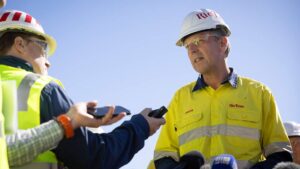Ground Breakers: Could BHP could be piloting ‘green steel’ by 2025?

Electric furnaces produce far less CO2 than conventional blast furnaces. Pic: Scanrail/iStock via Getty Images
- BHP and Hatch will study a design to pilot a low emissions steel technology using the global major’s Pilbara iron ore
- Pilot plant could be commissioned by 2025 if study succeeds
- Materials into the red as iron ore, lithium miners struggle
BHP (ASX:BHP) has been among the most candid of the big miners on its belief that the steel industry will continue to need coal long into the middle of this century.
It is a perspective that has coloured the mining giant’s investment decisions.
It has been happy to part with thermal and lower grade coking coal assets at the right price, sticking two of the mines that produce a softer steelmaking product in Daunia and Blackwater in Queensland on the market this year.
But BHP has maintained its grip of premium hard coking coal mines in the Sunshine State, adamant that higher quality met coal will help blast furnace steel producers, primarily in China, and achieve the best efficiency while still churning out the steel needed for, among other things, EVs, wind turbines and solar plants.
The lowest emissions pathway for steel at the moment is the electric arc furnace, primarily using scrap steel, or direct reduced iron, mainly using very high grades of iron ore made from magnetite ores, which need to be upgraded in an energy intensive process that makes them less economic than the ~62% hematite product BHP, Rio Tinto (ASX:RIO) and others can ship with minimal processing from the Pilbara.
But finding a pathway to reduce emissions from the steel production process is essential for BHP and Rio. Their Scope 3 emissions, those produced by customers overseas, dwarf their Scope 1 and 2 emissions generated onsite.
Even if they can hit net zero at home, plans to increase production going forward could mean a larger environmental impact on a global basis.
Wood Mackenzie estimates DRI grade iron ore would need to be produced at a rate of 750Mtpa by 2050 to help the steel industry hit net zero targets. That’s highly improbable given just 150Mtpa is produced at the moment and BHP and Rio’s Pilbara ores, among the largest hematite deposits in the world, can’t be upgraded to grab a share of that market.
To that end, both are studying methods to produce low emissions steel from their ores. BHP has announced what could be a major pilot to test the waters today.
Pilot by 2025?
BHP says it will work with global engineering firm Hatch to design an electric smelting furnace in support of a decision to construct a pilot facility in Australia, demonstrating a low CO2 intensity steel production method using BHP’s Pilbara ores.
It comes with BHP looking at plans to ramp up production capacity in the Pilbara from 290Mtpa to 300Mtpa in the near term and up to 330Mtpa in the long term.
BHP says when combined with a direct reduced iron ore step, electric smelting can reduce emissions by 80 per cent and potentially use renewable electricity as well as hydrogen to replace coking coal in the reduction process.
“We see the ESF process as a critical breakthrough in significantly reducing the carbon emissions intensity of steel production and one that provides an opportunity for iron ore from our Pilbara mines,” BHP chief commercial officer Vandita Pant said.
“The steel industry has identified the ESF as a viable option to use a wider range of raw materials and steel companies globally are looking to build commercial-scale ESF plants as part of their CO2 emission reduction roadmaps.”
BHP’s group sales and marketing officer Michiel Hovers said the collaboration was a “natural progression” of BHP’s partnership with Hatch, and that the two had collaborated on steel technology and design to reduce greenhouse gas emissions “for several years”.
If a decision is made to construct a pilot scale facility the process including construction would take around two years, with commissioning expected around 2025.
BHP (ASX:BHP) and Rio Tinto (ASX:RIO) share price today:
And on the markets?
In the short term iron ore miners are facing a mini-crunch with lower rebar steel prices in China signalling concerns about demand.
Rebar dropped 0.7% yesterday, with iron ore falling 1.3% to US$121.90/t. It had been trading at over US$130/t a week ago.
BHP, Rio and Fortescue (ASX:FMG) all fell.
Lithium chemical prices were flat overnight, with Fastmarkets reporting Asian hydroxide at US$66/kg and carbonate at US$54.50/kg.
Those are very high in historical terms but around 5-10% down on the month to date average, having both traded above US$80/kg late last year.
IGO (ASX:IGO), Mineral Resources (ASX:MIN) and Allkem (ASX:AKE) were all down, with Pilbara Minerals (ASX:PLS) the biggest slider at a 4.72% loss.
At $3.44, the lithium darling is at levels not seen since September last year.
While the materials sector was down 0.97% at 12.30pm AEDT, those declines were ameliorated by a handful of gold stocks, responding well to an expected 25bps lift in the US Fed’s rate, accompanied by language focusing more on financial and economic stability as opposed to a singular emphasis on inflation after the emergence of a new banking crisis in the States.
Ground Breakers share prices today:
Related Topics

UNLOCK INSIGHTS
Discover the untold stories of emerging ASX stocks.
Daily news and expert analysis, it's free to subscribe.
By proceeding, you confirm you understand that we handle personal information in accordance with our Privacy Policy.








